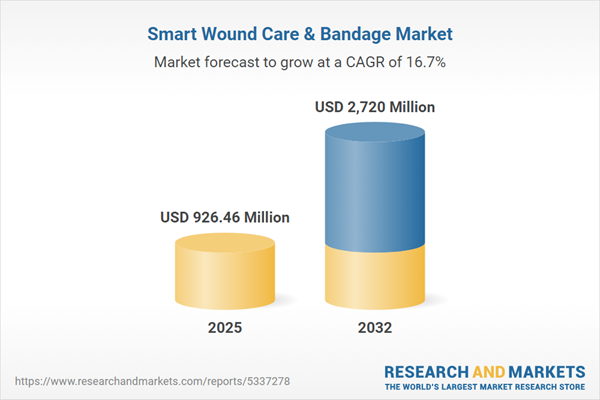Speak directly to the analyst to clarify any post sales queries you may have.
The global smart wound care and bandage market is advancing rapidly, shaped by digital transformation and growing clinical demand for personalized, connected wound management solutions. Decision-makers navigating innovation and operational strategy will find this report offers actionable intelligence on drivers, challenges, and future market positioning in the sector.
Market Snapshot: Growth Outlook in Smart Wound Care
The Smart Wound Care & Bandage Market grew from USD 792.39 million in 2024 to USD 926.46 million in 2025. It is expected to continue growing at a CAGR of 16.71%, reaching USD 2.72 billion by 2032. This trajectory reflects accelerated adoption of biosensor-enabled dressings, expanded clinical use cases, and increased investment in remote therapeutic monitoring. The market’s momentum is driven by strategic investments from multinational players, aggressive tariffs encouraging localized production, and heightened payer focus on outcomes-based reimbursement.
Scope & Segmentation of the Smart Wound Care and Bandage Market
- Product Types: Advanced dressings, NPWT systems (portable and stationary), traditional dressings including cotton gauze and nonwoven fabrics.
- Technology Focus: Embedded biosensing (oxygen, pH, temperature), drug delivery modalities (hydrogel-based, microneedle, nanoparticle), and stimuli-responsive features such as electroactive, photoresponsive, and thermoresponsive dressings.
- Wound Categories: Acute wounds (burn, surgical, traumatic) and chronic wounds (diabetic foot, pressure, venous leg ulcers).
- Distribution Channels: Clinics, hospitals, home healthcare providers, online channels, retail pharmacies.
- End Users: Clinical providers, home healthcare settings, hospitals, patients with self-care needs.
- Regional Coverage: Americas—including North America (United States, Canada, Mexico) and Latin America (Brazil, Argentina, Chile, Colombia, Peru); Europe, Middle East & Africa—including major European and Middle Eastern economies as well as key African countries; Asia-Pacific—including China, India, Japan, Australia, South Korea, Indonesia, Thailand, Malaysia, Singapore, and Taiwan.
- Industry Participants Profiled: Established multinationals and innovative start-ups, including Smith & Nephew plc, 3M Company, Mölnlycke Health Care AB, Convatec Group plc, Johnson & Johnson, B. Braun Melsungen AG, Coloplast A/S, Urgo Medical SA, Integra LifeSciences Holdings Corporation, and Essity Aktiebolag.
Key Takeaways: Strategic Insights for Leaders
- The convergence of digital health, advanced biomaterials, and real-time sensing technologies is transforming wound care from passive treatment towards continuous monitoring and adaptive therapy.
- Competing successfully in this market requires agile supply chain management and the flexibility to respond to new regulatory or tariff developments, particularly for companies with cross-border manufacturing dependencies.
- Adoption patterns differ notably by region: North America benefits from rapid regulatory approval cycles; Europe, Middle East & Africa show diversity in reimbursement and procurement; Asia-Pacific is scaling solutions for both urban and rural healthcare needs.
- Clinical differentiation is increasingly reliant on innovation in electroactive materials and integration with Internet of Medical Things frameworks for remote monitoring and drug delivery optimization.
- Product usability and real-world validation with clinical stakeholders are essential to achieving payer alignment and patient adherence.
- Strategic partnerships, ranging from co-development with universities to alliances with telehealth providers, are expediting market entry and extending care pathways.
Tariff Impact: Realignment of Supply Chains and Sourcing
Newly introduced United States tariffs for 2025 have prompted manufacturers to accelerate nearshoring, forge domestic supplier alliances, and invest in localized production. This shift is influencing supplier consolidation, leading to joint ventures that share technology and optimize manufacturing. Healthcare providers are re-evaluating procurement decisions to balance access to latest innovations with cost controls, while organizations with integrated, transparent supply chains gain competitive advantage.
Methodology & Data Sources
This report employs a rigorous mixed-method design, combining in-depth interviews with industry and clinical stakeholders, secondary analysis of regulatory records and scientific publications, as well as quantitative assessments of product pipelines and global supply networks. Findings are validated through triangulation across these sources and scenario modeling that anticipates regulatory and tariff changes.
Why This Report Matters to Senior Decision-Makers
- Pinpoints emerging technology and reimbursement trends that influence investment and operational priorities in smart wound care.
- Enables benchmarking of supply chain resilience, market entry strategy, and partnership potential in a shifting regulatory environment.
- Delivers a roadmap for capitalizing on product and service innovation while mitigating risks from tariffs and supply disruptions.
Conclusion
The smart wound care and bandage industry is entering a new phase of connected, data-driven therapies with differentiated solutions for diverse clinical needs. Informed strategy and proactive stakeholder collaboration remain vital to achieving market leadership in this dynamic environment.
Additional Product Information:
- Purchase of this report includes 1 year online access with quarterly updates.
- This report can be updated on request. Please contact our Customer Experience team using the Ask a Question widget on our website.
Table of Contents
3. Executive Summary
4. Market Overview
7. Cumulative Impact of Artificial Intelligence 2025
Companies Mentioned
The companies profiled in this Smart Wound Care & Bandage market report include:- Smith & Nephew plc
- 3M Company
- Mölnlycke Health Care AB
- Convatec Group plc
- Johnson & Johnson
- B. Braun Melsungen AG
- Coloplast A/S
- Urgo Medical SA
- Integra LifeSciences Holdings Corporation
- Essity Aktiebolag
Table Information
| Report Attribute | Details |
|---|---|
| No. of Pages | 180 |
| Published | October 2025 |
| Forecast Period | 2025 - 2032 |
| Estimated Market Value ( USD | $ 926.46 Million |
| Forecasted Market Value ( USD | $ 2720 Million |
| Compound Annual Growth Rate | 16.7% |
| Regions Covered | Global |
| No. of Companies Mentioned | 11 |









